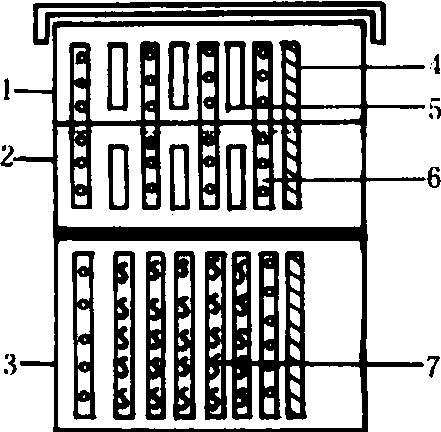巢蜜comb honey
有一定规格,可供人们直接食用的、带巢脾的封盖蜂蜜。依照不同要求和采用不同设备而生产的巢蜜,可分为格子巢蜜、大块巢蜜、切块巢蜜和混合块蜜;通常说的巢蜜,指的是格子巢蜜。巢蜜形状有方形、长方形、圆形和六边形。每块重量通常为200~350克。巢蜜可以保持蜜源植物原有的芳香,滋味鲜美,较分离蜜的酶值高,羟甲基糠醛和重金属含量低。由于巢蜜是劳动密集型的产品,并有以上优点,所以在世界市场上供不应求。
简史 巢蜜最初是一种天然品,在蜂巢内偶然可以从新酿造的白色蜜脾里采到,只有养蜂人能够享用。19世纪中叶发明活框蜂箱以后,1857年美国J.S.哈比森用薄木板制成矩形的小巢蜜格子,在浅继箱内生产格子巢蜜。以后蜂具工厂用木质轻软、色浅而无异味的整条薄椴木片,以专用机械大量生产可折合成型和有榫子的巢蜜格子,促进了巢蜜生产的发展。格子巢蜜在美国和欧洲迅速形成商品生产。19世纪下半期到20世纪初期,是欧美养蜂国家生产巢蜜的盛期。第一次世界大战期间,巢蜜生产明显减少。1953年以后欧美出现圆形巢蜜。80年代中国也进行了研究推广。
生产技术 四种巢蜜生产技术分述如下。
格子巢蜜 生产格子巢蜜需要具备3个条件:❶蜜源充足, 泌蜜稳定, 并且酿成的蜂蜜不易结晶, 色泽浅淡,气味芳香。
❷设备良好(见巢蜜生产工具)。
❸蜂群强壮。要选择12框蜂以上、健康无病、具有优质蜂王的蜂群生产巢蜜。当主要蜜源开花时, 撤去原来的继箱, 将蜂王和面积大的子脾留在巢箱里。多余的巢脾(包括部分虫卵脾), 将蜂抖落后调给其他蜂群。再在巢箱上加已安好巢蜜格的巢蜜继箱(浅继箱), 然后进行管理。生产格子巢蜜的工作内容主要包括:
加巢蜜格造脾和贮蜜 有两个蜜源衔接的地区,利用前一蜜源造脾,后一蜜源贮蜜;只有一个主要蜜源的地区,在主要蜜源未流蜜之前,宜先用蜜水喂足蜂群,促使加速造脾。用巢蜜框架生产巢蜜时,采用两个巢蜜继箱,每层巢蜜继箱放3排巢蜜格框,上下相对,与封盖子脾相间放置(图1)。当巢蜜格框贮上一半蜂蜜后,将封盖子脾放回巢箱,将巢蜜框架集中在一个巢蜜继箱内,撤走空的继箱,同时加第2个巢蜜继箱。第2个巢蜜继箱加在第1巢蜜继箱的上面,等到第2巢蜜继箱内的巢蜜格脾造好时,将第2巢蜜继箱移到第1巢蜜继箱的下面,即巢箱之上(图2)。第2巢蜜继箱充满一半以上蜂蜜时,照上述方法添加第3个巢蜜继箱。加第4、第5个巢蜜继箱的方法类推。采用T型巢蜜托架生产巢蜜时,宜将一未贮满蜜的蜜格作为诱饵,放在继箱内近中心位置上,以诱导蜜蜂上巢蜜继箱加速修造巢蜜格脾,提高巢蜜生产的成功率。

图1 巢蜜框架与封盖子脾相间放置示意图
1、2.浅继箱;3.巢箱;4.隔板;5.巢蜜框架;6.封盖子脾;7.卵虫脾

图2 添加巢蜜继箱顺序图解
控制自然分蜂 用于生产巢蜜的是经过选择的强大蜂群,生产期间把两个箱体减为一个箱体,上面只加一个巢蜜继箱时,容易促成分蜂热,发生自然分蜂。控制分蜂可采取两种方法:❶生产巢蜜的蜂群必须采用当年培育出的优良蜂王,每隔5~7天检查蜂群一次,及时毁除所有发现的王台,同时让蜂群生产王浆,扩大巢门。采用框架生产的,可以加两个巢蜜继箱,以适当扩大空间。必要时,将巢蜜生产群刚封盖的子脾与一般蜂群的幼虫脾交换。
❷生产巢蜜的蜂群内如发现王台,立即毁除,以后每隔三四天进行1次检查。在第2次检查时可能会找到更多的王台,这时应将蜂王杀死并毁掉所有王台。在除去蜂王后的第4天,应再次检查各群,并把所有的王台毁除。除去蜂王后的第8天,在毁掉所有王台后,诱入一个成熟王台或一只新产卵的蜂王。
平整封盖 蜜蜂习惯于在同一方向造脾,或者把蜂蜜装在巢脾后半部,前半部贮蜜较少,或因外界流蜜量大或饲喂量忽多忽少,容易出现封盖不平整的现象。为此,无论用托架还是框架生产巢蜜,在每行(或每两框)之间宜加一薄木板控制蜂路,以免蜜蜂任意加高蜜房;每次检查和调整巢蜜继箱时,将巢蜜继箱前后调头放置,促使蜜蜂造脾、贮蜜均匀;主要蜜源流蜜量大时,及时添加装有蜜格的继箱;饲喂时,根据贮蜜情况,掌握适宜的饲喂量和饲喂时间。
当主要蜜源即将结束,蜂箱内有部分巢蜜格尚未贮满蜜或尚未完成封盖时,可用同一品种的蜂蜜饲喂,早晚各一次,每次1.5千克。如果蜜格内已贮满蜜,但未封盖,可于每晚酌量饲喂,促使封盖。如果巢蜜格中部开始封盖,周围仍不完满,则限量饲喂,饲量不可过大。为便于加强通风,饲喂期间不宜盖严覆布。
采收与包装 巢蜜格贮满蜜并已全部封盖时,须及时取出。无论用框架式还是托架式,巢蜜格的封盖不可能完全一致,故须分期分批采收,切勿久置蜂群中,以防止蜡盖上由于蜜蜂往来而留下污迹。采收巢蜜用蜂刷驱逐蜜脾上附着的蜜蜂时,动作宜轻,以免损坏蜡盖。成批收获可用脱蜂板或吹蜂机,切不可用喷烟器驱蜂,以免蜜蜂受刺激后吸吮贮蜜和烟灰污染蜡盖。采回巢蜜后,用不锈钢薄刀片割去蜜格的边沿和四角上的蜂胶、蜡瘤及其他污迹。不能刮去的蜂胶污迹,可用纱布浸稀酒精擦拭。对完成的巢蜜可选择不易渗透封盖的熏蒸剂熏杀巢虫。整修巢蜜格时,对巢蜜格逐个挑选、分级、称重,分别用玻璃纸或无毒塑料薄膜封装,放入有窗口的纸板盒内或无毒透明的塑料盒内。
分级标准 巢蜜的分级与分离蜜完全不同,因为除了巢脾内的蜂蜜外,还有巢脾本身、封盖、重量和总的外观等,都与巢蜜质量有关。巢蜜的分级尚无统一标准。有按分离蜜的颜色分为白色、浅琥珀色、琥珀色、深琥珀色巢脾蜜。有按巢蜜的外表、颜色、封盖、格子清洁度、重量、结晶状况和花粉等8项的评分方法分级;美国农业部将巢蜜分为特级、一级、二级、级外4个等级。特级巢蜜的巢脾要求:❶除与格子连接的边行巢房外,无未封盖的巢房;
❷如边行为空巢房,与格子相连的面积要达到75%;或者边行巢房充满蜂蜜,与格子相连的面积达到50%;
❸巢脾不凸出格子边口以上;
❹无干巢房;
❺通孔总长度不超过21/2英寸(63.5毫米);
❻无花粉房。封盖要求:❶干燥、无因刷拭或其他原因造成的滴蜜或损坏;
❷除边行外,表面平整;
❸巢脾和封盖颜色符合该级官方色卡所描述的颜色。蜂蜜要求:❶整个巢脾内的蜂蜜颜色一致;
❷未受到结晶、甘露蜜、未成熟蜜、酸蜜、不良气味或其他原因的损坏。木格子要求:❶无蜂胶和其他污染;
❷表面光滑,是新的白色轻质椴木,无节痕。重量要求:除非另有说明,最低净重应为12盎司(340.2克)。一级巢蜜的标准是边行、四角的未封盖巢房不超过15个;与格子相连的面积达50%;通孔总长度不超过4英寸(101.6毫米);边行允许稍有不平整;净重最低11盎司(311.85克);颜色允许稍有色级的交叉,其他要求同特级。二级巢蜜的标准是边行、四角的未封盖巢房不超过30个,巢蜜内部未封盖房不超过5个,除边行外,与边行相邻的一行未封盖房不超过20个的空巢房;通孔总长度不超过6英寸(152.4毫米);无花粉、结晶蜜等的严重损害;颜色和表面不要求一致;净重不低于10盎司(283.5克)。不符合上述标准的为级外。
大块巢蜜 这是在巢蜜继箱内用浅巢框生产的大块封盖蜜脾。除了生产工具略有不同外,生产方法及蜂群的管理,均与用框架生产巢蜜相同。少数将整框蜜脾用蜡纸或玻璃纸包装或装在有窗口的特制的板匣内出售。多数是将大块巢蜜切块,以混合块蜜和切块巢蜜出售。
混合块蜜 是把切成块的巢蜜和分离蜜同装在一个容器内出售的蜂蜜,美国特级和1级混合块蜜的规格,要求容器内的巢蜜不少于容积的50%。
切块巢蜜 是将大块巢蜜按重量要求切成大小不同的蜜块,放在垫有浅盘的硬纱网上,滴干粘附在切割边缘上的液态蜜,或将其置于特制的分蜜机上用离心力把边缘的蜜甩干,用玻璃纸或聚乙烯口袋或透明塑料盒包装出售。
巢蜜comb honey
不加分离而带有一定规格巢脾的封盖蜂蜜。是一种高档的蜜蜂产品,可供人们直接食用。在流蜜期,将一定规格已固定好巢础的巢蜜格子放入强壮蜂群继箱中,经蜜蜂筑巢、贮蜜、酿制,最后封盖即成。巢蜜格子有木制或塑料制品,形状、大小根据需要设计,有圆形、正方形、长方形等;巢蜜可单面或双面;封盖后其重量有250 g、300 g或500 g等。最后装入包装盒(袋)内,成为商品。也有在浅继箱巢框内生产大块巢蜜,然后根据需要切割成一定大小和式样的巢蜜块,再行包装。巢蜜是一种优良的天然卫生食品,食用时切成小块,连巢脾带蜜在口中咀嚼,但不吞下巢脾蜡渣。